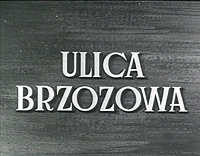 Ulica Brzozowa
Ulica Brzozowa
Poland, 1947, black and white, 9 mins
One of the key documentaries of Poland’s post-World War II pre-Stalinism era, Brzozowa Street takes its name and setting from one of the front lines of the Warsaw Uprising of 1944 – just three years before the film was made. Although Warsaw itself (at least according to Jerzy Piórkowski’s breathless commentary) is thriving, Brzozowa Street itself presents a more complex set of scenarios, being essentially a collection of crumbling buildings surrounded by piles of rubble, and whose weeds are doing at least as well as the hapless human inhabitants.
The commentary is right to pause at this point and emphasise the place’s beauty and poetry – these aren’t just any derelict slums, and a 1947 viewer would have been well aware of the reasons why the buildings are in such poor condition and the numberless acts of heroism that were carried out within them. Initially, it seems unlikely that anyone would voluntarily live here today, but the presence of fresh washing pegged out on a series of lines, and steam emerging from a pipe, quickly puts us right.

We’re then introduced to young Hania, who runs out of one of the buildings because, as the commentary puts it, “she’s nostalgic for the sun” (a need doubtless felt far more acutely by the resistance fighters in the Warsaw sewers three years earlier). She spots other children playing hopscotch and joins them. Floors are cleaned and flowers arranged – if the buildings are ruins, that shouldn’t prevent them from looking their best. An old woman slices open a largely rotten apple, but as it was presumably home-grown, its emotional value clearly trumps any defects. The cellars and basements are repurposed into flats – if they provided effective shelter from German bombs, they have no problem keeping out the weather. One inhabitant’s Alsatian keeps out various other things too, including prying documentary crews. In other words, as the commentary says, life goes on.
But after this oddly picturesque bit of scene-setting, the film moves into its second act: the reconstruction of Brzozowa Street. Builders begin to clear the rubble, and local businesses reopen – in the montage of Warsaw that began the film, we were treated to the sight of expensive handbags in the window of a shop in the fashionable Marzsalkowska Street. Its Brzozowa Street counterpart can’t hope to compete on luxuries (except children’s sweets), but it does at least provide basic staples. But, far more crucially for the area’s future, new buildings are beginning to be constructed – the commentary’s highlighting of the fact that they come complete with roofs shows how even something as basic as that couldn’t be taken for granted in this bombed-out environment.

Brzozowa Street offers a fascinating fusion of what would become two dominant trends in Polish documentary over the following decade. It anticipates Socialist Realism in its cheerfully upbeat and optimistic presentation of Warsaw’s reconstruction and the contribution everyone can make: a boy is shown making an elaborate toy glider (thus highlighting his potential as a construction worker), while towards the end of the film a group of children gaze skywards as though looking to the sun for inspiration. However, the film’s warts-and-all presentation of the often dreadful living conditions endured by the inhabitants of Brzozowa Street is closer to the ‘black series’ of documentaries from 1955-58 that lifted up the socialist realist stone and peered at what was writhing underneath. It’s very close in tone and content to Jerzy Bossak and Jarosław Brzozowski’s Warsaw ’56 (Warszawa 1956), one of the movement’s key titles, though it lacks that film’s memorably ruthless shock tactics.
Brzozowa Street also merits a minor footnote in Polish film history for being the professional (co-)directing debut of Wojciech Jerzy Has, who would go on to become one of the most distinctive Polish auteurs with such bizarre and fantastical masterworks as The Saragossa Manuscript (Rękopis znaleziony w Saragossie, 1965) and The Hourglass Sanatorium (Sanatorium pod Klepsydrą, 1973). But, as with the early documentaries of Andrzej Munk, there is little hint here of his future career and preoccupations, except perhaps in the poeticised treatment of the Brozozowa Street ruins, something a more workaday director might have ignored.
- Director/Script: Wojciech Jerzy Has, Stanisław Różewicz
- Camera: Władysław Forbert
- Music: Henryk Swolkień
- Commentary: Jerzy Piórkowski
- Production Company: Film Polski